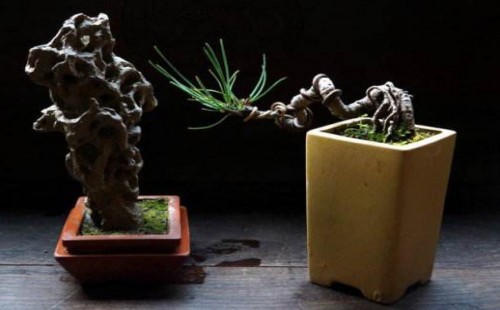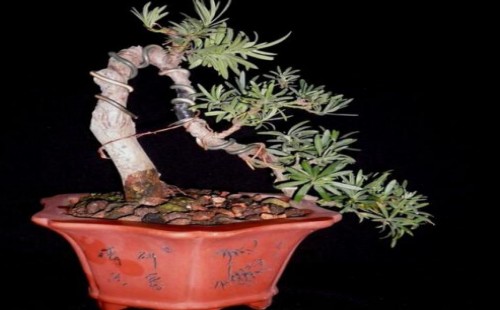What kind of wire is used in bonsai modeling?
There are many modeling techniques of bonsai trees, and different modeling techniques often need to be realized with the help of different tools or materials. Among them, the iron wire has a relatively high utilization rate, but considering that the general iron wire is tied to the bark, oxidation and corrosion will occur over a long time, and the wire will rust and break before we achieve the modeling effect we need. And rusty wire is often easy to cause some damage to the bound branches, so it is impossible to use ordinary wire. So, what kind of wire does bonsai use?

Bonsai in the modeling process will often use bending, pulling branches, hanging and other means, in addition to the use of rope, especially brown wire, the most commonly used is not to oxidize, rusty wire. By comprehensive comparison, it is usually most suitable to use aluminum wire or copper wire. This is a common banding technique in the modeling process of Su-style bonsai. Through the treatment of branches with the help of aluminum wire or copper wire, we can achieve the effect of banding and shaping, and finally complete the treatment of bonsai modeling, making bonsai more ornamental value.
The use of wire to shape bonsai is one of the most commonly used means in the process of bonsai plastic surgery, but it should be applied to the main branch first, then to the secondary branch, and finally to the twig, according to the principles of bottom-up, inside-out, and from thick to thin. The wire can be used alone, or multiple strips can be used at the same time. After one end is fixed, the wire can be used tightly. The metal is generally wound upward at an inclination angle of 45 °until it is wound to the desired position, and the end of the wire is attached to the branch so that it does not spread indiscriminately to avoid hindrance.
However, there is no unified requirement for the size of aluminum wire or copper wire used in the bonsai modeling process, but the size of the original aluminum wire or copper wire is directly related to the size of the branches. The purpose of using the wire is to fix the growth direction of the branch in the molding process, and the size of the wire depends on whether it can play a role in the fixed direction of the branch that has been tied. In the process of time, the wire with a diameter of about 1 mm is most used.
However, considering the cost, we generally need to choose a more cost-effective wire between aluminum wire and copper wire. Since copper wire of the same size and thickness is heavier than aluminum wire, the price will be higher. Therefore, economically speaking, it is often more affordable to use aluminum wire, and aluminum wire is lighter to use. But the aluminum wire also has its disadvantages, that is, it is easy to harden after a long time in the air, it will appear twist after use, and then it will become hard and brittle and easily broken.
If we want to continue to use aluminum wire, we can try to heat it to make it softer and tougher, which is like annealing steel. However, aluminum wire generally needs to be heated to about 500 degrees Celsius, and then let it naturally cool to room temperature before it can be used. However, it should be noted that aluminum wire also has its melting critical temperature, if the temperature is too high, it is easy to bake, so we should pay attention to control the temperature when baking. After the aluminum wire is cooled and softened, it can be easily straightened out in the shape of twist after use, and then reused.
Time: 2019-06-02 Click:
- Prev

Do banyan bonsai use deep or shallow pots?
Bonsai trees often have a strange and elegant shape, strong branches, and generally remain green all the year round, so they have high ornamental value, and banyan bonsai is one of the representative tree species. As we all know, the banyan bonsai is not only suitable for viewing leaves, but also very suitable for viewing roots.
- Next

How long can the bonsai wire be removed?
As we all know, making bonsai trees often requires the help of iron wires such as aluminum wire and copper wire to complete the auxiliary modeling. The use of iron wire to shape the branches is a common means in the bonsai shaping process, generally adopting the climbing process of first main branch, then subordinate branch, then twig, from bottom to top, from inside to outside, from thick to thin.
Related
- Fuxing push coffee new agricultural production and marketing class: lack of small-scale processing plants
- Jujube rice field leisure farm deep ploughing Yilan for five years to create a space for organic food and play
- Nongyu Farm-A trial of organic papaya for brave women with advanced technology
- Four points for attention in the prevention and control of diseases and insect pests of edible fungi
- How to add nutrient solution to Edible Fungi
- Is there any good way to control edible fungus mites?
- Open Inoculation Technology of Edible Fungi
- Is there any clever way to use fertilizer for edible fungus in winter?
- What agents are used to kill the pathogens of edible fungi in the mushroom shed?
- Rapid drying of Edible Fungi

